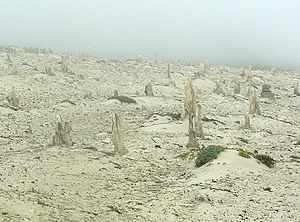
Caliche (/kəˈliːtʃiː/) (unrelated to the street-slang "Caliche" spoken in El Salvador) is a soil accumulation of soluble calcium carbonate at depth, where it precipitates and binds other materials—such as gravel, sand, clay, and silt. It occurs worldwide, in aridisol and mollisol soil orders—generally in arid or semiarid regions, including in central and western Australia, in the Kalahari Desert, in the High Plains of the western United States, in the Sonoran Desert, Chihuahuan Desert and Mojave Desert of North America, and in eastern Saudi Arabia at Al-Hasa. Caliche is also known as calcrete or kankar (in India). It belongs to the duricrusts. The term caliche is borrowed from Spanish and is originally from the Latin word calx, meaning lime.[1]
Caliche is generally light-colored but can range from white to light pink to reddish-brown, depending on the minerals present. Caliche is a mark of older landscapes. It generally occurs on or very near the surface. Where caliche layers originate at some depth from the soil surface, intact landscapes and buried landscapes are more likely than eroded surfaces to have caliche well below the soil surface. Layers vary from a few inches to feet thick, and multiple layers can exist in a single location. The caliche layer in a soil profile is sometimes called a K horizon.[2][3]
In northern Chile and Peru, caliche also refers to mineral deposits that include nitrate salts.[4][5] Caliche can also refer to various claylike deposits in Mexico and Colombia. In addition, it has been used to describe some forms of quartzite, bauxite, kaolinite, laterite, chalcedony, opal, and soda niter.
A similar material, composed of calcium sulfate rather than calcium carbonate, is called gypcrust.
- ^ Breazeale, J.F.; Smith, H.V. (15 April 1930). "Caliche in Arizona". Agricultural Experiment Station Bulletin. 131. University of Arizona: 419.
- ^ Gile, L. H.; Peterson, F. F.; Grossman, R. B. (February 1965). "The K Horizon". Soil Science. 99 (2): 74–82. Bibcode:1965SoilS..99...74G. doi:10.1097/00010694-196502000-00002. S2CID 129247211.
- ^ Allaby, Michael, ed. (2013). "Caliche". A dictionary of geology and earth sciences (Fourth ed.). Oxford: Oxford University Press. ISBN 9780199653065.
- ^ Chong et al. 2007, p. 211.
- ^ A Most Damnable Invention: Dynamite, Nitrates, and the Making of the Modern World, Stephen R. Bown, Macmillan, 2005, ISBN 0-312-32913-X, p. 157.